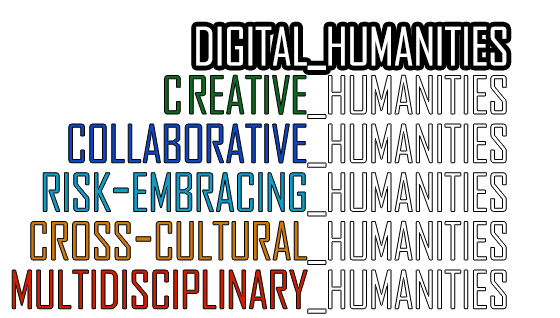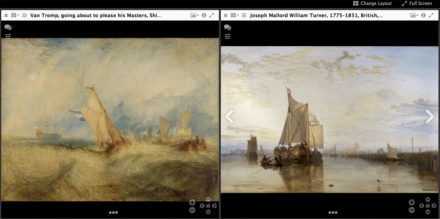
Yesterday colleagues across the Getty, including over 50 staff members and the directors of its four programs, gathered with Anne Burdick, Johanna Drucker, Peter Lunenfeld, and Jeffrey Schnapp, four of the authors of the recent book Digital_Humanities, to discuss how the Getty might contribute to the developing field of the digital humanities. (Due to a scheduling conflict, the fifth author, Todd Presner, was unable to join us.)
You might remember Murtha Baca’s Iris post on the book from just a few days ago. Murtha from the Getty Research Institute and Anne Helmreich from the Getty Foundation convened the meeting, and I moderated the discussion with and among the book’s authors.
I launched the discussion by noting that although the digital humanities emphasizes the curation, analysis, editing, and modeling of fact-based knowledge, we need to remember that the humanities are central to our knowing what it means to be human. They engage with questions of value and interpretation, with subjective judgments as well as verifiable truths. The quality of digital humanities work will only be as good as the thinking behind it. In this sense, “digital” is only a qualifier. The noun is humanities.
I also believe that, should the Getty contribute to the development of the digital humanities, it should be in a fundamental and not incremental way. The Getty Trust was founded 30 years ago to do what needs to be done and what others are not doing or are unable to do. If our contribution is just another website or platform, it would be a missed opportunity. So, what should we do next?
With that introduction, the authors each spoke briefly and then responded to questions from me and the audience for almost 90 minutes. It was a very lively discussion. I took away eight points (and no doubt others took away more and different points). Going forward, we should:
1. Take risks and not be afraid of failing. This applies to individuals as well as institutions, including the Getty.
2. Work across disciplinary boundaries. Unlike some of our university peers, cultural institutions such as the Getty are free of inherited disciplinary boundaries. This is a great opportunity.
3. Collaborate. For us, this means collaborating across the entire Getty Trust, working in teams representative of all four Getty programs, and with colleagues from other institutions. It also means working outside our disciplines, with colleagues from the start-up community, and with our users.
4. Do cross-cultural work. We should explore polycentric knowledge formation with colleagues from the rich multiverse of our fields’ many points of view.
5. Think “constellationally.” We should develop a new modality for working, what Johanna called a “constellational” modality: a means of working and publishing that is dynamic and interactive, and that embraces wide connections and deep creative thinking.
6. Publish in the full range of forms. This ranges from the extensive and expansive to the tweetable.
7. Make our data sets freely and broadly available. Sharing enables us all to benefit from one another’s efforts.
8. Invest in the long-term viability of our work. This means archiving and documenting projects, and planning for sustainability.
This discussion will continue over future months as we plan how the Getty can most benefit digital humanities, and strengthen the many collaborations already begun. I welcome your thoughts, now and moving forward.




Thank you for moderating yesterday’s conversation and sharing these thoughts. As a Getty staff member involved in social media, I was particularly excited by the discussion in yesterday’s panel about publishing. Rather than attempting to define “publishing” in the digital age, the panelists explicitly embraced the myriad forms knowledge now takes. The distinctions among social media, scholarly publishing, blogging, digital humanities web projects, and so forth, are increasingly eroding. Rather than erecting firmer and taller walls around each of our plots of land, what if we stipulated that we’re all pursuing the same goals in different ways? What could we accomplish together?
I think that’s right. I also think it’s inevitable that publishing will take a myriad of forms. That said, I think the protocols for each kind of publishing will and should remain in place. I mean, we need to know the difference between a scholarly monograph and a blog or between an exhibition catalog and a tweet. Each has its own kind of credibility and credibility is important.
As I listened to the conversation, I was struck by the potential the digital humanities hold for providing access across a wide array of platforms, with varying levels of content for audiences that may be less engaged by traditional means of learning, and I contemplated the role arts institutions like the Getty have in providing visual and historic context for events that have shaped human existence. The digital humanities must not become the domain of specialists, rather they must become the encyclopedia by and for the masses.
No doubt but still there’s a place for specialist exchange; that is, the back and forth between specialists on matters of interest only or primarily to specialists. What’s important is that we have a symphony of response options and not a cacophony of unmediated rant.
Certainly. I think yesterday’s repeated emphasis on editing and curation as key activities/skills has to do with mediation. To be a little simplistic about it: In creating content, editing is required to mediate the experience for the reader, so that the experience is meaningful and useful. (This is always guesswork, which is why user/visitor input is so crucial.) In engaging with others’ content, curation is required to mediate the experience for ourselves: to sift, find patterns in, and generally make meaning of the admittedly cacophonous Web.
There were so many intriguing ideas in the mix yesterday. Peter Lunenfeld said at one point that rather than replicating our thought process in a digital environment, we should augment, change, and differentiate it. I think that is an important point. Scholars will be able to address humanistic questions in different ways as digital technologies evolve and as they gain greater facility with them. Digital technologies have had a huge impact on the presentation and transmission of information, but they have the potential to change our perspective on the fundamental questions themselves.
I couldn’t agree more. That’s the real promise of the Digital Humanities. The more one knows about the potential of existing digital tools the more one will think differently, and not just about how to use those existing tools but about what new tools need to exist to meet the needs of thinking differently, I think the “thinking differently” part will come from working differently, collaboratively in person and online in shared workspaces.
I’m glad to see this issue discussed because it’s one I keep puzzling over myself. I would have liked to hear more from the panelists (or from anyone who has an idea) on how we might foster new ways of thinking and working as we go about creating publications (in whatever form). I’m being literal here: what practical steps could we take? Forming teams with content creators and technologists is clearly one path, but are there others we should be exploring?
You are quite right. We need to discuss this. What kind of publishing model do we want to pioneer – a constellational one? If so, that will help define the working group.
Hi Kara, This is such an interesting question. I am not sure if this along the same line, but I’ve been puzzling over a basic question in our work with social media/web/video: How do we be more creative? What does a creative process look like within a large organization? How do we give ourselves freedom to do new things? What are those “new things,” and how do we figure them out? (Obviously, keeping up with innovative work others are doing is important, but our ideas have to come from looking at our own mission, strengths, and challenges, and working outward from there.)
I have a couple of observations from my social media corner, practical steps that have yielded enormous rewards. First, more transparency: the best ideas I’ve encountered in the last six months as we’ve expanded our efforts have come from colleagues who don’t have a lot of experience in social media, but do have a real desire to collaborate and make our work better. To me, that implies that we need to benefit from the creativity of coworkers beyond individual small teams. What avenues for participation and feedback can we create? And second, putting our user/visitor at the center. Everything we do is for visitors/readers/users, but things change when we explicitly posit everything as being for their benefit. It forces the hard questions: Is this useful? Is this creative? Is this enjoyable? For whom? Why? How can we make it more so? (And this applies to the process, too: is the process of creating our work creative, enjoyable, and useful? The people who create the work are people too.)
Both of these are obvious: collaborate; make human experience our core focus. But they change the tenor of the work and thus the output.
I have been thinking a lot lately about what it means to “not be afraid to fail.” This phrase is tossed about a lot lately because it frees us to experiment and to take risks. I think this is on point. In the digital realm (perhaps in all realms?), a methodology of experimentation can be very fruitful. But I think there’s a more important shift that this phrase signifies–a shift in what it means to succeed. Perhaps we need to re-define what success looks like? If success is about learning, about new relationships, and about refining, then we shift our focus from an end-product to the process itself. As you said at the end of this discussion, there is a need to be modest about all of this change. Modesty is required in order to be open to learning new things, to collaborating, and to reflecting on our process. If we can accomplish these things, we cannot call it failure.
Many thanks for this. I like the shift from end result to process. I think that’s spot-on. I suppose some people think well in isolation but most recent innovation, whether in science or technology, has come through process-oriented, team-based work.
As a graduate intern with the Vocabulary Program and a graduate of UCLA’s information studies department, I was extremely interested in Monday’s discussion. Although I was familiar with many of the ideas discussed, placing them within the institutional context of the Getty was both thought-provoking and exciting. However, I think that our excitement about the future and the “new” sometimes causes us to overlook current projects that may already be in line with these goals. For instance, the Cultural Objects Name Authority (CONA) is a project that seeks to make a very large set of cataloging data available openly available (a goal that was mentioned many times during Monday’s discussion). Additionally, as Murtha mentioned, translating the Getty Vocabularies into Linked Open Data would allow scholars to both think and work “constellationally” on the web. While I do think that the Getty and other institutions should move forward in developing experimental digital humanities projects, perhaps we should also consider reinvesting resources into existing programs and projects that target the very same goals. Thank you very much for hosting and moderating such a stimulating and important discussion.
Many thanks. Foundational projects like these will continue to flourish, I am certain.
I really enjoyed listening to the thoughtful session yesterday, and was especially happy to read your point about collaboration, an essential tool for cultural institutions embarking on digital projects today. The web is creating a world not divided by subject or even location, and the Getty is uniquely situated to make a major impact when in collaboration with other partners, with projects like OSCI leading the way.
Collaboration also means listening and evaluating more—what do our visitors, users, or colleagues want? How can we best participate? What is success (as noted by SE above)?
All good points. We have to keep in mind the diversity of our users and visitors and the range of our offerings, from those directed to the general, least art historically prepared users/visitors to the most highly prepared, and also that our users/visitors (probably more users than visitors) are scientists, art historians, museum professionals, and humanists.
Thank you to Dr James Cuno, and The Getty for their truly foundational work in transitioning the humanities, and particularly art history to a collaborative, inclusive workflow which confidently uses, develops and adapts digital and traditional tools to achieve its aims.
The longer term potential for this type of work to enrich global cultural awareness and communication is truly profound, as well as maximising the flow of information between specialists, researchers and the public. Of course, much hard work lies ahead, yet the stage seems to be set for many exciting projects, great and small that will share the beauty of knowledge and inquiry in an unprecedented manner.
Many kind regards
Hasan Niyazi
Thanks Hasan. Your response is truly inspiring. The promise of the internet to cross borders and promote cultural understanding is huge. That must be our ultimate aim. After all, the internet is being used for just the opposite reason too: to promote hatred and xenophobia from within policed borders. Thank you for raising our sights on the true purpose of cultural institutions in our age of increasing sectarian violence.